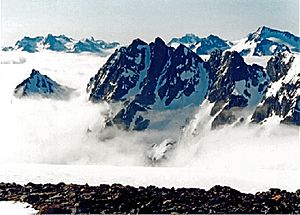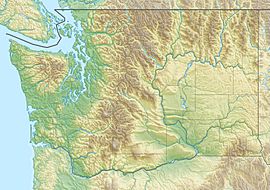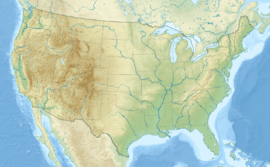Mantis Peak facts for kids
Quick facts for kids Mantis Peak |
|
|---|---|

|
|
| Highest point | |
| Elevation | 7,614 ft (2,321 m) |
| Prominence | 574 ft (175 m) |
| Isolation | 1.11 mi (1.79 km) |
| Parent peak | Snowfield Peak (8,351 ft) |
| Geography | |
| Location | North Cascades National Park Skagit County, Washington, U.S. |
| Parent range | North Cascades Cascade Range |
| Topo map | USGS Ross Dam |
| Climbing | |
| First ascent | Mantis Peak: August 16, 1973, by Marilyn and Stan Jensen. Distal Phalanx: May 31, 1981, by John Roper, Dave Stonington, Ted Hegg, Charlie Janeway |
Mantis Peak is a tall mountain located in North Cascades National Park in Washington state. It has two main tops, making it a "double-summit" mountain. Even though its name is "Mantis Peak," this is not its official name.
The mountain stands at about 7,614 feet (2,321 meters) high. It is close to Snowfield Peak and Styloid Peak. Water from Mantis Peak flows into Neve Creek and McAllister Creek. These creeks then join Thunder Creek.
The north side of Mantis Peak is very steep. It has been shaped by the Neve Glacier. The mountain rises sharply, about 4,000 feet (1,219 meters) from the valley below. The south side rises even more, about 5,400 feet (1,646 meters).
The first people to climb Mantis Peak were Marilyn and Stan Jensen. They reached the top on August 16, 1973. The slightly higher twin top, called "Distal Phalanx", was first climbed later. John Roper and his team climbed it on May 31, 1981. John Roper was a doctor, and he often named mountains after parts of the human body.
Weather at Mantis Peak
Mantis Peak is in a marine west coast climate zone. This means it gets a lot of rain and snow. Most of the weather comes from the Pacific Ocean. These weather systems move towards the Cascade Mountains.
When the weather fronts hit the tall mountains, they are forced to rise. This causes them to drop their moisture as rain or snow. This process is called Orographic lift. Because of this, the western side of the North Cascades gets a lot of precipitation.
During winter, there is heavy snowfall. The snow can be wet and heavy. This often leads to a high risk of avalanches. Winters are usually cloudy. However, in summer, high pressure systems over the Pacific Ocean bring clear skies. The best time to visit or climb Mantis Peak is from July to September.
How Mantis Peak Was Formed
The North Cascades area has very rugged land. You can see sharp peaks, spires, and deep glacial valleys. These features were created by geological events over millions of years. These events caused big changes in the land's height and led to different climates.

The Cascade Mountains started forming millions of years ago. This was during the late Eocene Epoch. The North American Plate was moving over the Pacific Plate. This movement caused a lot of volcanic activity.
Also, small pieces of the Earth's crust, called terranes, came together. This helped create the North Cascades about 50 million years ago.
During the Pleistocene period, which was over two million years ago, glaciers played a big role. They moved across the land many times, carving out the landscape. They left behind piles of rock debris. The "U"-shaped river valleys you see today were formed by these glaciers.
The tall peaks and deep valleys of the North Cascades were mainly created by two processes. These are uplift (when land rises) and faulting (when cracks form in the Earth's crust). Glaciation also helped shape the area.



